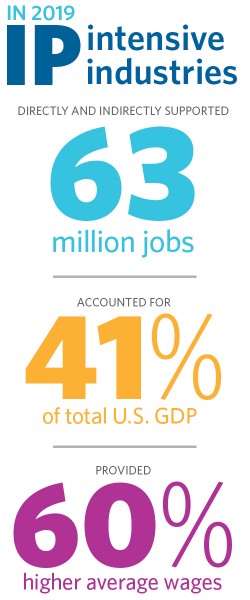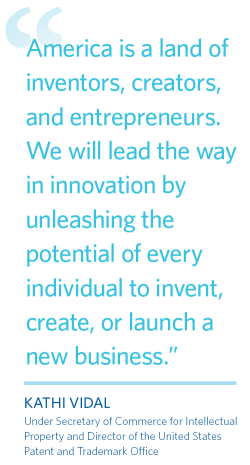Learn how inclusive intellectual property initiatives support both individual innovators and the broader U.S. economy.
The importance of equity in innovation
Research has shown that inventing and entrepreneurship are crucial to the United States’ economic success; however, it has also revealed significant disparities in opportunities to innovate across the country. The United States Patent and Trademark Office (USPTO) has a vital role in ensuring equity in innovation and is working to address these concerning statistics. Below, we explore how expanding access to the innovation ecosystem is key to both our nation’s competitiveness and our citizens’ well-being.
Maintaining our nation’s position as a leader in global innovation

The importance of American innovation and intellectual property (IP) protection has its earliest roots in article I, section 8, clause 8 of the U.S. Constitution, which “promote[s] the Progress of Science and useful Arts, by securing for limited Times to Authors and Inventors the exclusive Right to their respective Writings and Discoveries,” and in article I, section 8, clause 3, which supports the federal registration of trademarks.
IP is as crucial to our economy today as it was over 200 years ago. In 2019, for example, IP-intensive industries directly and indirectly supported 63 million jobs, and 41% of the total U.S. Gross Domestic Product (GDP) was attributable to those industries. Also in 2019, workers in IP-intensive industries earned an average weekly wage that was 60% higher than the average weekly wage in other industries.
However, the United States now faces more global economic competition than ever before. To remain competitive, we must encourage Americans from diverse backgrounds and geographic locations to participate in the innovation ecosystem. We need more women, veterans, and those from other underrepresented groups to invent, establish businesses, and pursue careers in the field of IP.
To accomplish this objective, we must overcome many challenges. Currently, for example, American children from high-income families are 10 times more likely to become inventors than those from lower-income families, and white people are more than three times as likely to become inventors as Black people. Furthermore, the share of women among all U.S. inventor-patentees was just 12.8% in 2019.
If we address these disparities, we could quadruple the number of American inventors. Federal initiatives to increase diversity, inclusion, and accessibility in the innovation ecosystem could advance social justice and boost productivity, while also increasing the GDP per capita by as much as 4%. The USPTO is committed to offering programs and events to support these goals, while ensuring that an emphasis on equity remains central to our operations.
Driving the development of American businesses and entrepreneurs

The USPTO’s work to advance equity is especially crucial for American business owners, entrepreneurs, and independent inventors. Our programs and policies foster innovation and provide a reliable, predictable, high-quality IP system for all participants in the innovation ecosystem, and we strive to ensure that everyone has the resources necessary to succeed.
However, many factors influence access to the innovation ecosystem. Opportunities available to aspiring innovators, for example, vary significantly by race, gender, and socioeconomic status. In addition, the concentration of innovative activity in certain parts of the country creates considerable disparities among inventors and entrepreneurs. The collective effect of unequal access is profound, with negative impacts on both the development of local communities and the social and economic well-being and competitiveness of the country as a whole.
With greater access to the innovation ecosystem, inventors and business owners will be more empowered with the tools and resources to improve their living standards, cultivate their businesses, and develop their inventions. Startups that receive patents, for example, experience an average of 55% higher employment growth and 80% higher sales growth within five years of their patent grants. Many patent recipients also undertake further innovations after obtaining their first patent. If we, as a nation, can build an innovation economy that more closely reflects the diversity of our citizens and enables everyone to invent, start businesses, and access IP protection, we will all benefit from the wealth of previously untapped abilities. The USPTO is dedicated to advancing this endeavor.
Visit new website!
References
Alex Bell, Raj Chetty, Xavier Jaravel, Neviana Petkova, and John Van Reenen, "Who Becomes an Inventor in America? The Importance of Exposure to Innovation," Quarterly Journal of Economics 134, no. 2 (May 2019): 647-713.
Joan Farre-Mensa, Deepak Hegde, and Alexander Ljungqvist, "What Is a Patent Worth? Evidence from the U.S. Patent ‘Lottery,’" Journal of Finance 75, no. 2 (April 2020): 639-82.
Jennifer Hunt, Jean-Philippe Garant, Hannah Herman, and David J. Munroe, "Why Don’t Women Patent?" March 2012.
Audra Skukauskaite, Stephanie Couch, and Leslie Flynn,
"Researching Invention Education: A White Paper," November 2019.
USPTO, "Intellectual Property and the U.S. Economy: 2021 Update."
USPTO, "Progress and Potential: 2020 update on U.S. women inventor-patentees."

